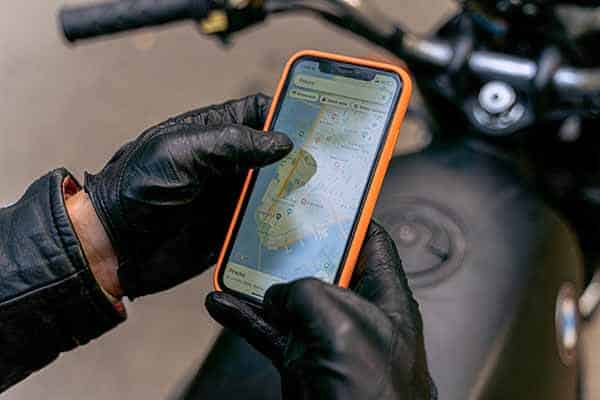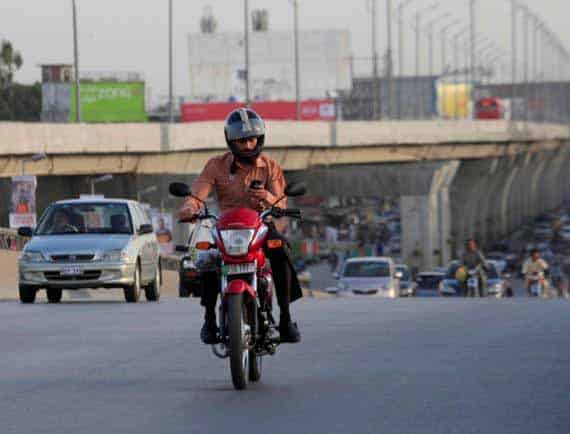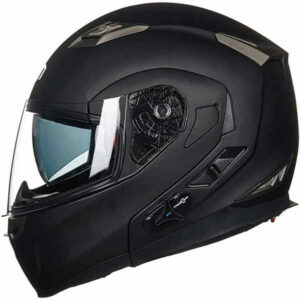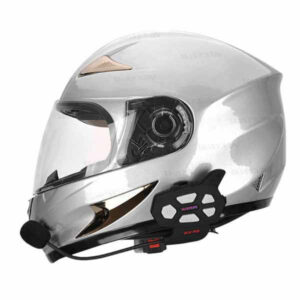Unless it’s hands-free, using a phone on a motorcycle isn’t advised. Most states have clear rules against texting while driving for cars, but the situation is a little murkier for two-wheelers.
As a rule of thumb, never hold and talk on the phone while riding a motorcycle, as it takes your eyes off the road, and when going at a decent speed, this is dangerous. Even though it’s legal to use your phone, GPS, or music functions while riding if it’s in an approved cradle-with your finger and the phone securely mounted on the bike and not obscuring your view of the road or your motorcycle instruments and gauges.
We still think it’s too risky and recommend pulling over, getting a Bluetooth motorcycle helmet, or using a Bluetooth headset or earbuds if you must use your phone while riding. Read on to learn how to do these safely without harming yourself or others.
Find Out the 4 Best Ways To Avoid Talk on the Phone While Riding a Motorcycle
Get a Bluetooth Helmet
We’re all accustomed to having our phones on us all the time. You never know when you’ll need to make a call or use your GPS hence the need for a Bluetooth motorcycle helmet. These types of helmets include a Bluetooth slot, enabling you to use a wireless headset with your phone to monitor your route or call someone without taking your hands off the handlebars.
But using Bluetooth for communication is about more than simply making phone calls to your loved ones. This equipment may also be used in an accident. In an emergency, you could struggle to get your phone out, but a voice-activated Hands-free 9-1-1 call is possible using a Bluetooth helmet.
Overall, you don’t have to stop or risk crashing your bike to use your phone. Bluetooth technology is here to make riding simpler. Connect your phone to a wireless Bluetooth helmet to maximize your travel time and remain safe.
Related: Top 16 Lightest Motorcycle Helmets With Bluetooth 2021
Bluetooth Motorcycle Headset
Some nations consider Bluetooth communication unlawful; however, there are no stringent rules in the US, so you should be OK. Find a headset that matches your gear’s manufacturer and model. It should have a perfect fit in your helmet.
After installing the headset, attach your phone to your bike using a dedicated grip or device holder. It should have a good hold on your smartphone. Mount on or near the handlebars for easy visibility. The screen shouldn’t be too far down. But the phone shouldn’t block your vision.
Bluetooth intercom makes it safe to use your phone while riding, but it doesn’t mean you should ignore the road. Distracted driving is still possible. In fact, it’s the main cause of motorbike accidents! But the headset lets you use your phone securely without endangering others. It would be best if you utilize it responsibly. Keep your chats brief and your eyes on the action.
Try out your new setup before taking it out. Practice answering calls and utilizing GPS in a parking lot or residential street.
Wear Earphones in a Helmet
The white wire with two earphones, a microphone, and an answer switch is normally included with purchasing a phone. Alternatively, aftermarket alternatives are available.
This option only works with full-face helmets unless the microphone is put on a stalk in front of the rider’s lips.
Use an earphone set that has the following features to integrate with your full-face helmet:
- A long wire connects the earpiece and the microphone. This is required to connect the microphone to the front of the helmet near your lips for efficient voice pickup.
- A call-activation switch around the microphone or farther down the wire
- Attachment to fix the microphone
Accepting calls requires pressing the microphone button with your left hand. Test your comfort with receiving phone calls before you ride out into the wide blue yonder. Ensure that everything is comfortable and that the call can be readily taken.
Pulling Over to Use Your Phone
You’ll need to pull over if you don’t have Bluetooth or need to do more on your phone. Slow down and pull over in a clear spot where you are visible to other motorists. Allow plenty of room between your bike and the nearest stop signal. After stopping the motorcycle, remove your keys and helmet to use your phone.
This might be a lengthy procedure, particularly if the text was just “OK.” That’s why most riders use Bluetooth speakers. You can use all functionalities without endangering others.
In Summary
The problem isn’t laws. Using a cell phone while riding a motorcycle is a bad idea, particularly while holding one. It’s risky since it takes your eyes off the road. Rather, use a Bluetooth motorcycle helmet, Bluetooth headset, or earphones, or pull over to use your phone
|
Conclusion: Michael’s wrap-up and summary The problem isn’t laws. Using a cell phone while riding a motorcycle is a bad idea, particularly while holding one. It’s risky since it takes your eyes off the road. My guess is that if you are reading this article you want to use a phone on a motorcycle and don’t want to read that you shouldn’t use one! so if you must talk on the phone while riding at least, use a Bluetooth motorcycle helmet, Bluetooth headset, or earphones, or pull over to use your phone. As you have probably heard 1000 times being distracted is one of the greatest risks while riding a motorcycle. I have found while riding in Southeast Asia that it’s even possible to have a dangerous distraction just by using the GPS feature on a mobile phone so one must always be careful not to let your mind drift off of actually riding the motorcycle. If you focus your attention on the ride, on your motorcycle, and on the environment instead of your mobile phone chances are that will greatly reduce your risk of having an accident and there’s always time to talk on the phone later. |
About the author: Michael Parrotte was the Vice President of AGV Helmets America, and a consultant for KBC Helmets, Vemar Helmets, Suomy Helmets, Marushin Helmets, KYT Helmets, Sparx Helmets. In addition, he is the founder and owner of AGV Sports Group.
FM/A




